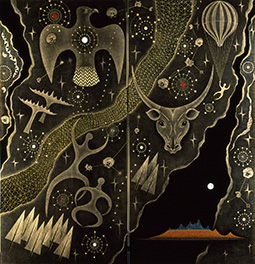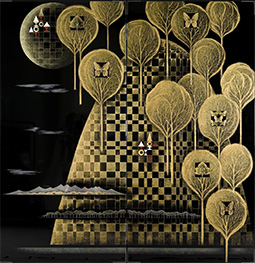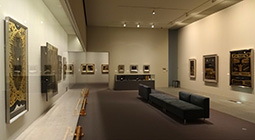May 2022
- English
- 日本語
Turning Traditional Lacquer Art into Contemporary Art: The Work of Takahashi Setsuro

The mountainous countryside of Azumino where Takahashi was born 
Takahashi Setsuro Art Museum of Azumino

Takahashi Setsuro (1914–2007) 
Flowering Stars of the Heavens (lacquered folding screen, detail) (1992) by Takahashi Setsuro, featuring motifs from the nature and scenery of Azumino City, Nagano Prefecture (length 176 cm x width 173 cm) 
Ancient Tombs of Many Seasons (lacquered folding screen, detail) (1984) by Takahashi Setsuro (length 172 cm x width 175 cm) 
Brilliant Constellation (lacquered folding screen, detail) (1988) by Takahashi Setsuro (length 175 cm x width 172 cm) 
Exhibition room

Takahashi Setsuro (1914–2007) was a lacquer artist who created many unique works using new techniques that he pioneered based on age-old and traditional methods in Japanese lacquer art. He was an artist who turned lacquer art into a new style of contemporary art.

Japanese lacquerware developed as a traditional art and craft mainly through the production of familiar everyday tools such as tableware, chopsticks and boxes to hold letters. By contrast, rather than making items of practical use, Takahashi Setsuro created two-dimensional painting-like works such as lacquered panels and folding screens whose main function is purely ornamental. In particular, his lacquer panels earned high praise as a new form of contemporary art distinct from traditional lacquer artworks.

Takahashi Setsuro was born in the countryside surrounded by nature with views of nearby mountain peaks 3,000 meters high, in present-day Azumino City, Nagano Prefecture, roughly in the center of Japan’s Honshu island. Tominaga Junko, curator at the Takahashi Setsuro Art Museum of Azumino, says of the artist, “Takahashi Setsuro was a person who created a completely new contemporary art out of the extremely traditional material that is lacquer. He possessed a wonderful compositional and design ability to depict the detailed handiwork of lacquer art as large-scale works on big screens.”

Takahashi Setsuro thought that “the most beautiful lacquer is black with maki-e gold, and after that vermilion,” so he did not use many colors but created a variety of works using only lacquer in the three colors of black, gold and vermilion. In particular, Takahashi’s favorite motif was the nature and scenery of Azumino where he had spent his childhood, themes which he reproduced on panels and folding screens. One of his most well-known works, Flowering Stars of the Heavens, is a two-panel folding screen. It is inlaid with numerous motifs inspired by the galaxies and stars you see when looking up from Azumino and the area’s ancient tombs. It conveys a majestic worldview that seems to manifest the connections between people, the universe, and the earth through deep black and gold that glitters like precious stones, with vermilion acting as an accent to show the mountain ranges of the artist’s home town. The work as a whole has a mysterious quality.

To express such a mysterious worldview, Takahashi repeatedly researched methods to express fine lines and give more vibrance to shades of gold and shadow effects, devising his own technique called “sokin.” Takahashi applied suri-urushi* to engravings of patterns, embedded gold dust and gold leaf just before the lacquer dried, and wiped off excess gold to reveal delicate gold markings.
Using this sokin technique, he made Tales of the Fossils, unveiled in 1964. It was a work that married excellent technique with expressive perfection and was something that he described as “a monumental work for me, in terms of both technique and design.”


In 1997, the Japanese government awarded Takahashi Setsuro the Order of Culture for being an artist of outstanding achievements. Subsequently, he continued to present major works until his death in 2007 at the age of 92. He left behind a legacy seemingly engraved on the cutting edge of Japan’s long history of lacquer art.
* A kind of lacquering technique. Raw lacquer is painted thinly on plain wood, emphasizing the beauty of the grain.

